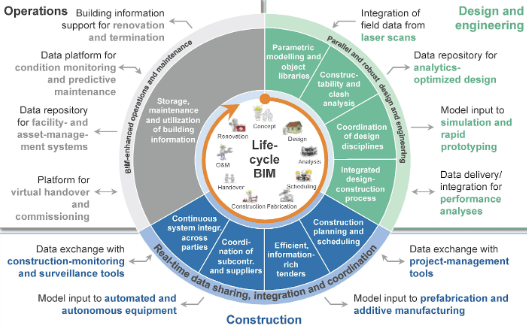Digital transformation has revolutionized many industries around us. The construction sector shaped by the rise of Building Information Modeling, or information modeling, is no exception. The demand for BIM projects and professionals is growing worldwide and the diffusion of the methodology has brought up many questions regarding the BIM implementation. In this article, you will be able to get the answers to the most recurring BIM questions and solve the most frequent doubts about this subject.
What is BIM?
BIM is a work methodology that consists of digital construction of a building or a infrastructure that involves collaborative work between several players involved in the project. In case of BIM, one virtual model contains all the information of the life cycle of the project, which can be added and changed in real time.
What are the advantages of BIM?
Thanks to the collaborative work environment and information that can be added in real time to the virtual model, Building Information Modeling allows the users to have a preview and a wider overview of the project. Thus, the methodology makes it easier to avoid mistakes, interferences, improvisations and refactorings, which reduces the time and cost invested in the project.
What is BIM used for in architecture and engineering?
BIM has the function of representing the development of the building or infrastructure within the environment that it will be inserted (city, neighborhood, street, etc), while simulating the structure's behavior regarding the climate, energy efficiency, safety, convenience and material consumption. With all this data it is possible to have an overview of social and economic impacts and benefits of the construction throughout its useful life.
Is BIM a software?
BIM is not just a software, this oversimplified view, that does not correspond to reality, is slowly decreasing. BIM is much more than an innovation of technology, it is a work methodology. Through diverse technological tools and the collaborative work integrates all the information of the construction. And, doing so, it optimizes the project and makes the flow of execution and management easier.
Which professionals and which areas can apply BIM?
The BIM methodology should be applied in all disciplines that constitute the project (from architecture to electrical, hydraulics, telecommunications, air conditioning, fire prevention and atmospheric discharge prevention system, automation and other installations). Therefore BIM can be used at all times throughout the cycle (design, planning, execution, management and maintenance) and by all the players involved in the project. Regardless if they are engineers, architects, designers, budgeteers, managers or builders.

Source: The Boston Consulting Group
What is the current state of BIM in the world and which countries require the use of BIM in architecture, engineering and construction?
BIM in architecture, engineering and construction is already widespread in many parts of the world and has become a requirement for government-funded projects in countries such as the United Kingdom, Denmark, Finland, the Netherlands, Sweden, Norway and the USA.
In South Korea BIM is mandatory for public buildings and private projects that have an investment of more than 50 million dollars.
But in Chile, the methodology is required for hospital bids.
In 2019, BIM will be obligatory for government works in Russia and will also be mandatory for public tenders for infrastructure works in Spain.
In Singapore, the Building Construction Authority, which is part of Singapore's National Development Ministry, requires an approval system for architectural, structural, hydraulic, electrical and air-conditioning projects via BIM model analysis, this system being the fastest in the world (today it takes about 26 days, but the body plans to reduce this deadline to 10 days in total).
The use of BIM is encouraged by the European Union, since 14 countries have joined and created the EU BIM Task Group.
Researchers from Ireland have created the Global BIM Study - Lessons for Ireland's BIM Program, which presents the status of BIM's membership in public works in several nations.
It is predicted that the use of BIM methodology will become obligatory in Germany, France and Australia. It will be for the public projects in the years to come. Even though not mandatory, Brazil, New Zealand, Canada, Chile, Peru, Saudi Arabia, China and Japan use BIM on a regular basis.
Why is there still resistance to BIM implementation?
There is still resistance to the adherence of the methodology because BIM implementation requires a considerable investment in knowledge and technology necessaries for the process. That is, it is essential to achieve the training of an entire chain of professionals involved in the project.
BIM also requires companies to invest in technology (software and cutting edge computers). In addition, adherence to the methodology often requires the restructuring of the company and the creation of a new workflow.
In which aspects is BIM beneficial?
Transparency - Collaborative work enables the participation of all players, who have access to all the information and details available for all areas of the work.
Real-time data update - Technology combined with collaborative work allows you to integrate and change drawings and details automatically.
Unique language for all - BIM enables integrated communication between all parties involved.
Intelligent drawing - The drawings have detailed information, for example, calculations can be done automatically and information is added simultaneously to the graphic part of the project.
Geographical evaluation of the project location - BIM allows an analysis of the geographic and social impacts of the structure to see the viability of the construction work in the given location.
More effective execution - By virtually representing the project and still counting on the collaborative work of all the parties involved, BIM makes it possible to predict errors and avoid unforeseen events, as well as verify the feasibility of the construction site, which makes the project more efficient, reducing time and cost overruns.
Precise timeline - BIM is present throughout all phases of the project's life cycle, and when associated with a schedule of activities, it enables all space requirements, work resources, materials and deliverables to be transmitted.
Personal, company and country marketing - BIM has become a competitive advantage among the professionals of the industry: for architectural and engineering offices and construction companies alike. At the same time, BIM has also the potential to bring better results to governmental management.
Where can I get more information about BIM?
Books, masterclasses, courses, masters, architecture and engineering blogs, online magazines focused on the construction industry, academic articles and dissertations, events, youtube channels, manufacturers' websites and standards’ and technical manuals.
In addition, more information about BIM in architecture, engineering and construction is available through BIMCommunity, the world's largest BIM community, which still allows the professional to create their own content, introduce their projects, meet other professionals and companies, and keep an eye on the job opportunities. The international blog portal also allows companies to announce job opportunities and gain prominence in the market.


 Source: The Boston Consulting Group
What is the current state of BIM in the world and which countries require the use of BIM in architecture, engineering and construction?
BIM in architecture, engineering and construction is already widespread in many parts of the world and has become a requirement for government-funded projects in countries such as the United Kingdom, Denmark, Finland, the Netherlands, Sweden, Norway and the USA.
In South Korea BIM is mandatory for public buildings and private projects that have an investment of more than 50 million dollars.
But in Chile, the methodology is required for hospital bids.
In 2019, BIM will be obligatory for government works in Russia and will also be mandatory for public tenders for infrastructure works in Spain.
In Singapore, the Building Construction Authority, which is part of Singapore's National Development Ministry, requires an approval system for architectural, structural, hydraulic, electrical and air-conditioning projects via BIM model analysis, this system being the fastest in the world (today it takes about 26 days, but the body plans to reduce this deadline to 10 days in total).
The use of BIM is encouraged by the European Union, since 14 countries have joined and created the EU BIM Task Group.
Researchers from Ireland have created the Global BIM Study - Lessons for Ireland's BIM Program, which presents the status of BIM's membership in public works in several nations.
It is predicted that the use of BIM methodology will become obligatory in Germany, France and Australia. It will be for the public projects in the years to come. Even though not mandatory, Brazil, New Zealand, Canada, Chile, Peru, Saudi Arabia, China and Japan use BIM on a regular basis.
Source: The Boston Consulting Group
What is the current state of BIM in the world and which countries require the use of BIM in architecture, engineering and construction?
BIM in architecture, engineering and construction is already widespread in many parts of the world and has become a requirement for government-funded projects in countries such as the United Kingdom, Denmark, Finland, the Netherlands, Sweden, Norway and the USA.
In South Korea BIM is mandatory for public buildings and private projects that have an investment of more than 50 million dollars.
But in Chile, the methodology is required for hospital bids.
In 2019, BIM will be obligatory for government works in Russia and will also be mandatory for public tenders for infrastructure works in Spain.
In Singapore, the Building Construction Authority, which is part of Singapore's National Development Ministry, requires an approval system for architectural, structural, hydraulic, electrical and air-conditioning projects via BIM model analysis, this system being the fastest in the world (today it takes about 26 days, but the body plans to reduce this deadline to 10 days in total).
The use of BIM is encouraged by the European Union, since 14 countries have joined and created the EU BIM Task Group.
Researchers from Ireland have created the Global BIM Study - Lessons for Ireland's BIM Program, which presents the status of BIM's membership in public works in several nations.
It is predicted that the use of BIM methodology will become obligatory in Germany, France and Australia. It will be for the public projects in the years to come. Even though not mandatory, Brazil, New Zealand, Canada, Chile, Peru, Saudi Arabia, China and Japan use BIM on a regular basis.
